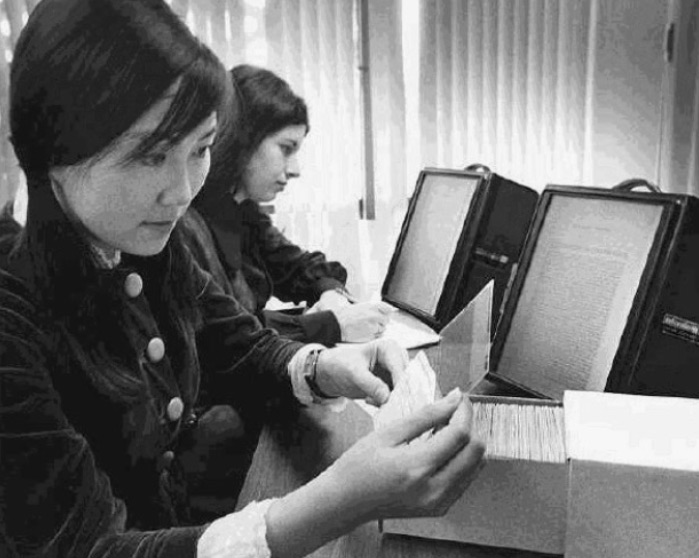How We Learned before the Internet
Suitcase-sized ‘portables’ and harried AV runners brought data and images to students
College of San Mateo has been in the vanguard of instructional technology for decades, from its adoption of UHF televised learning in 1963—the year UHF sets came to market—to its nationally recognized networked computer curriculum in 1997 to its digital media program and Library Makerspace today. Looking back, though, the IT tools of decades past seem quaint and awkward now.
In the mid-20th century, CSM students did a lot of their library research on microfiche, small plastic sheets that contain miniaturized images of printed pages— about 98 pages on each 4 x 5-inch sheet. Periodicals and reference works were microfiched so they would use less storage space than full-sized paper copies.
Using microfiche was eye-strainingly tedious. The machines used to read them had no way to search for keywords on the page. Individual sheets were handled carefully by their edges: No fingerprints allowed!
Even so, the technology truly advanced access to education, because it let more people research materials that only the biggest libraries could previously afford to buy and to store.

By the 1960s, the CSM library held 14,000 microfiche sheets representing about 1.4 million pages of reference materials. CSM even acquired portable microfiche readers for students to take home.
Like most research libraries, CSM still owns microfiche and modern devices to read it. Now, though, CSM students do research digitally on their laptops or cellphones. They have easy access to a vast resource network through the CSM Library website —not just the databases and holdings of the San Mateo County Community College District, but also the countywide Peninsula Library System.
Distributing yesterday’s learning tools were what former Media Center manager Helen Souranoff called the “schleppers”—workers, often students, who would scramble to distribute projectors, televisions and other AV equipment to CSM classrooms in the days before digital media.
For budgetary reasons, and also because technology changed so greatly over College Heights’ lifetime, not all of CSM’s 100-plus classrooms had a video closet with a built-in projector. Souranoff, starting as a student worker in 1981, had the logistical challenge of getting a finite number of media devices to classrooms before each lecture began.
“In 1981, there were no elevators except for Bldg. 1 and Bldg. 9 (the Library),” Souranoff remembered. “We carried TV sets up the stairs to Buildings 14, 16, and 18. It would take two of us to carry them up the stairs. It was tough, laborious and it was also fun.”
“The College didn’t have enough money to furnish all the classrooms. So we’d hide projectors in closets to carry them to the classrooms that needed them. It happened every hour on the hour Monday, Wednesday, and Friday and on Tuesday and Thursday every hour and a half. We called it Red Dot time.”
“Once the big hand reached the numeral 10 on the clock, that was Red Dot time. We’d load up the truck and drive up the hill. Three or four student assistants jumped out of the truck and delivered the material. In all kinds of weather.”
Souranoff liked the work, she said, “because I like to be instrumental.” She went on to a career of CSM service including Media Services Manager, Theatre Events Manager and technical director of Jazz on the Hill, retiring in 2016.

